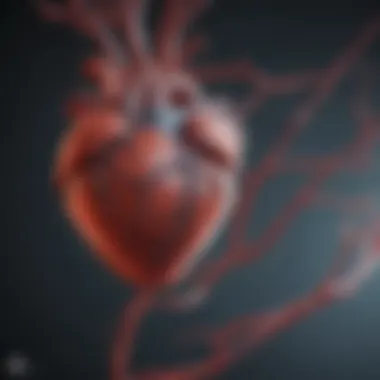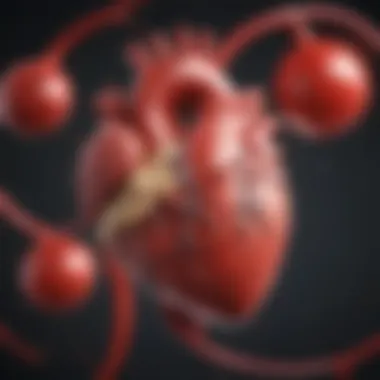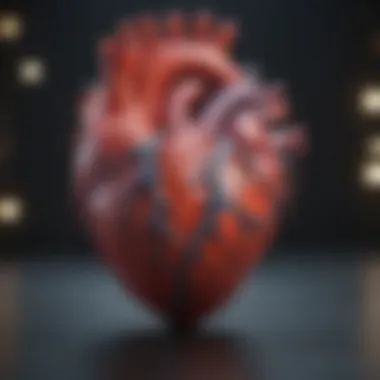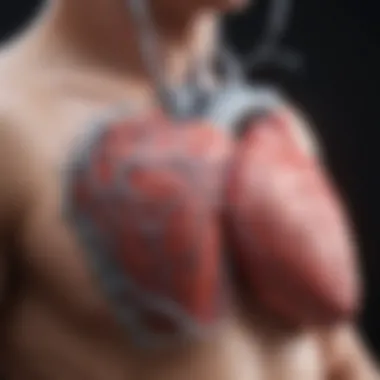Understanding Heart Repolarization: Mechanisms & Impact


Intro
The repolarization of the heart is an intricate process, vital for ensuring the correct rhythm and function of cardiac tissues. Understanding this stage is crucial for students, researchers, and healthcare professionals alike, as it has direct implications for diagnosing and treating various cardiac conditions.
At the molecular level, repolarization involves the movement of ions, primarily potassium, across the cell membrane of cardiac myocytes. This movement restores the membrane potential after each heartbeat, allowing the heart to prepare for its next contraction. Anomalies in this process can lead to arrhythmias, which can be life-threatening.
In this discussion, the physiological mechanisms behind repolarization are examined. We delve into how repolarization interacts with other stages of the cardiac cycle and what factors might influence its effectiveness. Moreover, we will look into the importance of ion channels in this process, highlighting not only their functions but also any potential pharmacological implications.
By breaking down the complexities of heart repolarization, we can appreciate its importance in maintaining cardiac health and its implications in disease states. A detailed understanding opens avenues for more effective treatment strategies in cardiology.
Prolusion to Cardiac Repolarization
Cardiac repolarization plays a vital role in maintaining the rhythm and function of the heart. It facilitates the restoration of the resting state of cardiac cells after each contraction. Understanding this process is essential for both clinical and academic audiences as it intersects with numerous aspects of cardiovascular health.
Overview of Cardiac Function
The primary function of the heart is to pump blood throughout the body, ensuring that all organs receive adequate oxygen and nutrients. This function relies on a finely tuned electrical system that governs the contraction and relaxation of cardiac muscle. At its core, cardiac function encompasses three key phases: depolarization, contraction (systole), and repolarization. Depolarization triggers the heart's contraction, ultimately leading to blood being expelled. Following this, repolarization is crucial as it resets the electrical state of the heart's cells, preparing them for the next cycle of activity.
During this overview, it is important to highlight how disturbances in repolarization can lead to significant cardiac issues such as arrhythmias. For health professionals and researchers, a deeper understanding of these mechanisms will facilitate both diagnosis and treatment of cardiovascular diseases.
Importance of Repolarization in Cardiac Cycle
Repolarization is not just a passive recovery phase; it is an active process that holds critical importance in the cardiac cycle. Efficient repolarization ensures that the heart returns to its resting membrane potential, allowing it to be ready to respond to the next electrical impulse. The phases of repolarization closely interact with various ion channels, particularly sodium, potassium, and calcium channels.
If repolarization is delayed or abnormal, as seen in certain pathological conditions, it may result in serious complications like torsades de pointes, a type of life-threatening arrhythmia. Furthermore, studies show that the timing of repolarization can impact the overall health of the cardiovascular system, underscoring the need for ongoing research and exploration in this area.
"Repolarization is the unsung hero of the cardiac cycle, quietly ensuring that the heart is ready for its next beat."
Electrophysiology of Cardiac Cells
The study of electrophysiology in cardiac cells is crucial for understanding the intricate mechanisms underlying heart function. This area explores how electrical signals initiate and propagate through cardiac tissues, thereby influencing the heart's ability to contract and relax. The specific elements within this field offer insights into the physiological basis of cardiac rhythms, the incidence of arrhythmias, and the response of the heart to various stimuli. Moreover, recognizing these processes lays the groundwork for therapeutic strategies aimed at restoring normal cardiac function.
Resting Membrane Potential
The resting membrane potential refers to the electrical charge difference across the cell membrane when the cell is not actively firing. In cardiac cells, this potential is typically around -90 mV, which is primarily determined by the distribution of ions, particularly sodium, potassium, and calcium. Understanding this concept is essential because it establishes the baseline electrical state of the cell.
This potential is maintained by the sodium-potassium pump, which expels sodium ions from the cell while bringing potassium ions into it. The permeability of the cell membrane to potassium is notably higher than that of sodium. Consequently, these ions play a pivotal role in setting up the resting membrane potential. Deviation from this state can lead to significant changes in cardiac excitability and conduction.
Action Potential Phases
The action potential of cardiac cells can be delineated into distinct phases, each characterized by specific ionic movements across the membrane. These phases are fundamental to the initiation and propagation of electrical signals in the heart.
- Phase 0: Depolarization
- Phase 1: Initial Repolarization
- Phase 2: Plateau Phase
- Phase 3: Final Repolarization
- Phase 4: Resting Phase
- This phase begins with a rapid influx of sodium ions through voltage-gated sodium channels, resulting in a sharp increase in membrane potential. This significant change triggers subsequent electrical activity in surrounding myocardial cells.
- Following depolarization, sodium channels close and potassium channels open. This allows potassium to exit the cell, leading to a brief drop in membrane potential.
- During this phase, calcium ions flow into the cell through L-type calcium channels, compensating for potassium efflux. This provides a sustained depolarization that is critical for the heart's pumping action, as it prolongs the action potential duration.
- In this phase, calcium channels close and additional potassium channels open, leading to further repolarization of the cell membrane toward its resting state. This phase is essential for the heart to reset its electrical state, preparing for the next cycle of contraction and relaxation.


- The resting potential is re-established following the action potential, allowing for recovery before the next trigger begins the cycle anew.
The balance of ion movements during these phases is vital for the heart's rhythm and function. Disturbances in any of these phases can lead to arrhythmias or other cardiovascular issues, underscoring the importance of understanding the electrophysiology of cardiac cells for both clinical and research purposes.
Stages of Cardiac Repolarization
The stages of cardiac repolarization are crucial to understanding how the heart maintains its rhythm and function. This process is divided into specific phases, each marked by distinct ionic movements across the cardiac cell membranes. Recognizing these stages provides insights into the overall cardiac function and assists in identifying potential arrhythmias or other cardiac disorders. It emphasizes the essential role of repolarization in restoring the resting state of the heart after each contraction.
Phase 1: Initial Repolarization
During initial repolarization, there is a rapid change in the membrain potential of cardiac muscle cells. This phase follows the peak of the action potential. Specifically, sodium channels close, and potassium ions begin to exit the cell, causing a quick decrease in membrane potential. This movement is largely due to the action of voltage-gated potassium channels. As a result, the intracellular environment becomes less positive, setting the stage for the subsequent phases of repolarization. This phase is very significant as it marks the transition from depolarization to repolarization.
Phase 2: Plateau Phase
The plateau phase is characterized by a sustained depolarization of cardiac myocytes. Here, calcium channels open, allowing calcium ions to flow into the cells, balancing the efflux of potassium ions. This phase is essential for myocardial contraction. The prolonged depolarization prevents the heart from entering a state of tetany, which could lead to inefficient pumping of blood. The plateau phase ensures adequate blood is circulated throughout the body by maintaining the contraction for a sufficient duration. This phase is particularly influential in the ventricles and is vital for effective heart function.
Phase 3: Final Repolarization
Final repolarization is marked by the rapid return of membrane potential to its resting state, which is close to -90 mV. During this phase, calcium channels close, and there is an increased efflux of potassium ions. This helps to restore the resting state of cardiac cells and prepares them for the next cycle of depolarization. This rapid phase is critical to maintain a healthy heart rhythm. Disturbances in this final phase can lead to various arrhythmias that can compromise cardiac function. Understanding the dynamics of this phase can aid in identifying therapeutic targets in conditions characterized by abnormal repolarization.
In summary, the stages of cardiac repolarization play a pivotal role in the cardiac cycle, ensuring that the heart can pump effectively and rhythmically. Each phase contributes uniquely to the overall function, highlighting the complexity of cardiac physiology.
Ion Channels Involved in Repolarization
Ion channels play a pivotal role in the process of cardiac repolarization. Their function is essential for restoring the resting membrane potential after a cardiac action potential. They ensure the heart muscle cells can properly recharge for the next cycle of depolarization. Understanding these channels helps reveal the intricate dynamics of heart function and provides insight into various cardiac pathologies.
Role of Sodium Channels
Sodium channels are crucial during the early stages of cardiac action potentials. Initially, they open in response to depolarization, allowing a rapid influx of sodium ions into the cell. This influx is responsible for the rapid upstroke seen in the action potential. As the membrane potential rises, sodium channels begin to inactivate. This inactivation is necessary to halt the entry of sodium ions and set the stage for repolarization. Without proper functioning of sodium channels, the heart's electrical activity can become erratic, leading to arrhythmias.
Contributions of Potassium Channels
Potassium channels are fundamental during repolarization. They help restore the negative membrane potential by allowing potassium ions to flow out of the cell. There are several types of potassium channels, each contributing differently. Some are activated by voltage changes, while others respond to metabolic factors. Particularly, the delayed rectifier potassium channels facilitate the final repolarization phase. The balance between sodium channel activity and potassium channel activity is critical. Disruptions, such as in certain cardiac diseases, can lead to prolonged repolarization or other complications.
Calcium Channels and Their Function
Calcium channels also play a significant role in cardiac repolarization, particularly during the plateau phase of the action potential. They permit calcium ions to enter the cell, which is essential for muscle contraction. However, as repolarization progresses, the inactivation of calcium channels contributes to the overall decline in intracellular calcium concentration. This decline is necessary for the muscle to relax after contraction. The interaction between calcium and potassium channels is vital for the orderly progression of the cardiac cycle. Any dysfunction in calcium channel operation can negatively impact heart rhythm and contractility, which in turn affects overall cardiac health.
"The intricate balance of ion channels is the foundation of cardiac electrophysiology, ensuring efficient heart function and health."
Understanding the roles of these ion channels can help inform treatments for various cardiac conditions. Emerging research continues to explore how modifying channel function can influence cardiac disease outcomes.
Control of Cardiac Repolarization
Control of cardiac repolarization is a fundamental aspect tied to the heart's rhythm and overall function. Understanding this control can offer insights into various cardiovascular conditions that may arise when mechanisms regulating repolarization are disrupted. Proper repolarization ensures that the heart muscle relaxes efficiently after each heartbeat, preparing it for the next contraction. It interlinks with many physiological processes necessary for maintaining homeostasis in the body.
The two primary systems governing cardiac repolarization are the autonomic nervous system and hormonal regulation. Each plays a distinct but complementary role in how the heart responds to both internal and external stimuli.
Influence of Autonomic Nervous System
The autonomic nervous system (ANS) significantly influences cardiac repolarization through its sympathetic and parasympathetic components. The sympathetic nervous system releases norepinephrine, which enhances the heart rate and force of contraction by affecting ion channel activity. This effect can lead to a quicker repolarization phase under stress or during physical activity, facilitating the heart's responsiveness. Contrarily, the parasympathetic nervous system, mediated primarily by the vagus nerve, promotes relaxation and decreases cardiac output. The release of acetylcholine can prolong repolarization, allowing for a more leisurely heart rhythm when the body is at rest.
Key points about the influence of the ANS are:


- Sympathetic stimulation speeds up repolarization, enhancing heart rate.
- Parasympathetic stimulation prolongs the repolarization phase, encouraging a calm heart pattern.
- Balance between these systems is vital for optimal cardiac function.
Hormonal Regulation
Hormones also contribute significantly to the control of repolarization processes. Several hormones, including epinephrine and norepinephrine, can modulate the variability and pacing of heartbeat. When the body encounters stress, these hormones elevate, causing increased heart activity, altering repolarization time and properties.
Other hormones, like aldosterone and angiotensin II, also impact repolarization indirectly by regulating vascular resistance and blood volume. Electrolyte homeostasis also plays an important role in this aspect of hormonal regulation. Abnormalities in potassium, sodium, and calcium levels can significantly influence repolarization dynamics.
"The harmony of heart function lies in the intricate balance between the neural and hormonal influences shaping cardiac repolarization."
By enhancing knowledge in this area, we can cultivate better preventive and management strategies for patients suffering from cardiac dysregulation.
Pathological Conditions Impacting Repolarization
The study of cardiac repolarization goes beyond normal physiology; it extends into various pathological conditions that can significantly impact heart function. Understanding these conditions is essential. It provides insights into how disruptions in repolarization can lead to severe cardiac events. By recognizing these implications, professionals in the medical field can better diagnose and manage conditions related to heart health.
Arrhythmias and Their Mechanisms
Arrhythmias are irregular heartbeats resulting from altered electrical signaling. These disruptions can arise from faulty ion channel function, ischemia, or structural changes in the heart. Various types of arrhythmias exist, including atrial fibrillation, tachycardia, and bradycardia. Each presents its own set of mechanisms affecting cardiac repolarization.
Key mechanisms involve:
- Abnormal ion current: Changes in sodium or potassium currents can lead to prolonged repolarization, resulting in arrhythmias.
- Re-entry circuits: Some arrhythmias stem from abnormal electrical pathways, causing the impulse to circle back.
- Automacity: Certain heart cells may acquire the capacity to depolarize spontaneously, disrupting normal rhythm.
These mechanisms are vital to address, as they can lead to complications like stroke or heart failure. Diagnosing the type of arrhythmia often requires advanced techniques like electrophysiological studies.
Myocardial Ischemia Effects
Myocardial ischemia, characterized by reduced blood flow to heart muscle, produces distinct effects on cardiac repolarization. Ischemia can cause significant potassium gradient alteration due to cell damage. When the heart is ischemic, the cellular environment changes, affecting ion channels critical for repolarization.
Implications of ischemia include:
- Altered repolarization dynamics: Ischemic conditions can lead to a longer repolarization phase, increasing the potential for arrhythmias.
- Stunned myocardium: This refers to temporary post-ischemic contractile dysfunction, which may also reflect altered repolarization.
- Re perfusion injury: Upon restoration of blood flow, oxidative stress can provoke additional myocardial damage and further disrupt repolarization balance.
These factors underscore the necessity for timely recognition and intervention in ischemic heart disease to prevent severe consequences.
Electrolyte Imbalances
Electrolyte imbalances can significantly impact cardiac repolarization. Important ions like potassium, calcium, and magnesium play critical roles in maintaining electrical stability within cardiac cells. An imbalance can lead to altered conduction and affect the heart’s ability to repolarize correctly.
Specific electrolyte conditions to consider include:
- Hypokalemia: Low potassium levels can lead to prolonged repolarization and increased risk of arrhythmias.
- Hyperkalemia: Excess potassium can cause shortened repolarization and elevate the risk of lethal ventricular arrhythmias.
- Calcium dysregulation: Changes in calcium levels can disturb the plateau phase of action potentials, further complicating the repolarization process.
- Magnesium deficiency: This can also affect potassium and calcium levels, leading to arrhythmias.
These factors illustrate how vital electrolyte levels are for maintaining a normal heart rhythm. Addressing these imbalances is crucial for restoring proper cardiac function.
Understanding these pathological conditions and their effect on repolarization emphasizes the need for ongoing research and clinical awareness in cardiovascular health. It opens avenues for improved treatments and interventions that can save lives.
Clinical Significance of Repolarization
Understanding the clinical significance of cardiac repolarization is crucial for evaluating heart health and diagnosing various cardiac conditions. The repolarization phase is essential in determining how well the heart can reset after each contraction. Any complications in this phase can have profound implications for overall cardiovascular health.


ECG Assessment of Repolarization Abnormalities
An electrocardiogram (ECG) serves as a vital tool in assessing repolarization abnormalities. By measuring the electrical activity of the heart, an ECG can reveal deviations in repolarization that highlight potential issues:
- Prolonged QT Interval: This can indicate an increased risk for arrhythmias, which are serious disorders of heart rhythm.
- T Wave Abnormalities: Changes in the T wave morphology can suggest ischemia or electrolyte imbalance.
- ST Segment Changes: Elevations or depressions here can highlight myocardial infarction or other cardiac stressors.
A thorough analysis of ECG findings can lead to early intervention, possibly preventing life-threatening situations.
Pharmacological Implications for Treatment
Pharmacological treatment aims to correct repolarization irregularities and restore normal heart rhythm. Various drug classes target the ion channels involved in repolarization:
- Antiarrhythmic Medications: Drugs such as Amiodarone or Sotalol manage and prevent arrhythmias by altering ion channel function, allowing for better synchronization of cardiac cycles.
- Electrolyte Replacement Therapy: Administering potassium or magnesium can address electrolyte imbalances, which are common causes of repolarization issues.
- Beta-blockers: Medications like Metoprolol have a role in managing elevated heart rates and decreasing myocardial oxygen demand, indirectly benefiting repolarization stability.
Future Directions in Repolarization Research
Research into cardiac repolarization has made significant progress, but many avenues remain to explore. Understanding the mechanisms that govern this crucial process can enhance treatment strategies and provide deeper insights into cardiovascular health. Innovations in this field promise improved patient outcomes through more reliable monitoring and advanced therapies.
Emerging Technologies in Cardiac Monitoring
Technological advancements play a pivotal role in the future of cardiac monitoring. Devices like wearable ECG monitors and implantable loop recorders have revolutionized how clinicians observe heart activity in real-time. These technologies enhance the detection of repolarization abnormalities that may lead to arrhythmias or other complications.
- Wireless Monitoring: New wireless technologies allow for continuous monitoring of cardiac activity outside traditional clinical settings. This paves the way for proactive management of heart conditions.
- AI and Machine Learning: Algorithms based on artificial intelligence analyze ECG data to identify patterns indicative of repolarization issues. This enables earlier intervention and more tailored treatment plans for patients.
These advancements not only facilitate immediate clinical responses but also contribute to long-term studies of heart health in diverse populations.
Potential for Gene Therapy
Gene therapy opens new frontiers for addressing repolarization disorders on a molecular level. Research indicates that specific genetic modifications could correct dysfunctional ion channel activity that leads to abnormal repolarization. This approach holds promise for conditions like long QT syndrome and other hereditary arrhythmias.
- Targeted Gene Editing: Techniques such as CRISPR-Cas9 allow for precise modifications in genes responsible for the ion channel function in cardiac cells. This specificity can minimize off-target effects, thus improving safety.
- Gene Delivery Systems: Innovations in how genes are delivered to target cells also enhance effectiveness. Viral vectors and nanoparticles are being explored for their potential to deliver therapeutic genes directly into cardiac tissues.
The impact of these developments could transform how we treat and manage heart rhythm disorders, offering hope for conditions that currently have limited treatment options.
The exploration of gene therapy in cardiac repolarization signifies a potential shift from symptomatic treatment to addressing root causes.
In summary, the future directions in repolarization research are bright, marked by exciting technological innovations and groundbreaking therapeutic approaches. The continued emphasis on these areas will likely yield significant advances in our understanding and treatment of cardiovascular diseases.
Epilogue
The conclusion of this article encapsulates the core findings regarding cardiac repolarization, emphasizing its vital role in maintaining heart functionality. The mechanisms of repolarization are crucial not just for academic understanding but also for practical implications in cardiology and public health.
Summary of Key Points
In summary, this exploration of cardiac repolarization has highlighted several important aspects:
- Phases of Repolarization: The article thoroughly discussed the distinct phases involved, specifically initial repolarization, plateau, and final repolarization.
- Ion Channel Dynamics: The key players in this process—sodium, potassium, and calcium channels—play specific roles that significantly impact the entire cardiac cycle.
- Autonomic and Hormonal Influences: The regulation of repolarization by both the autonomic nervous system and hormonal factors indicates the complexity of cardiac regulation.
- Clinical Implications: Understanding the repolarization process allows for better assessment of abnormalities and the implications for treatment strategies, particularly in arrhythmias and other cardiac pathologies.
Implications for Cardiovascular Health
The implications of cardiac repolarization extend deeply into cardiovascular health. A comprehensive grasp of repolarization mechanisms aids in the development of effective interventions for various heart conditions.
For healthcare professionals, recognizing early signs of repolarization abnormalities on ECG can lead to timely diagnosis of potential arrhythmias.
Moreover, advancements in our understanding of repolarization can influence therapeutic approaches. For instance, pharmacological treatment options can be tailored based on how ion channel dysfunction contributes to arrhythmias.
In the future, research into gene therapy holds promise for correcting underlying genetic disorders affecting repolarization, enhancing overall cardiac health outcomes.
The ongoing investigation into cardiac repolarization is critical for both preventive measures and therapeutic solutions in the ever-evolving field of cardiology.



